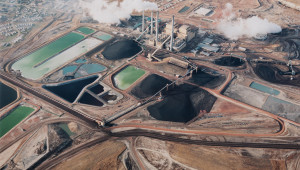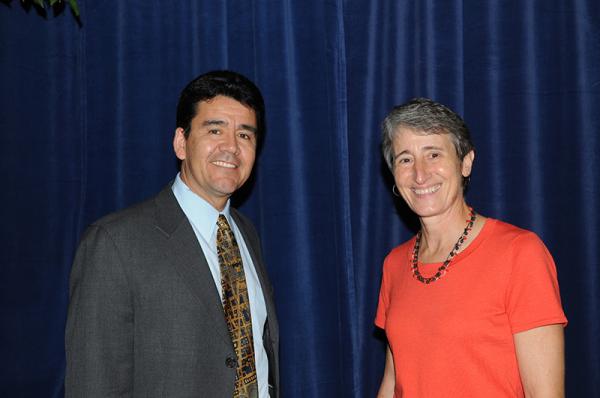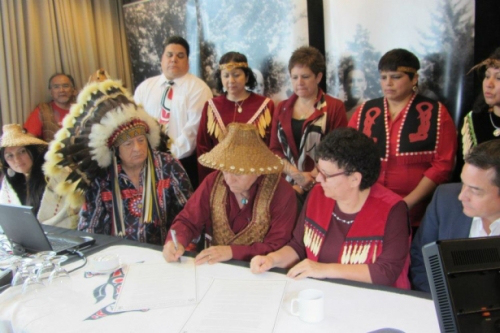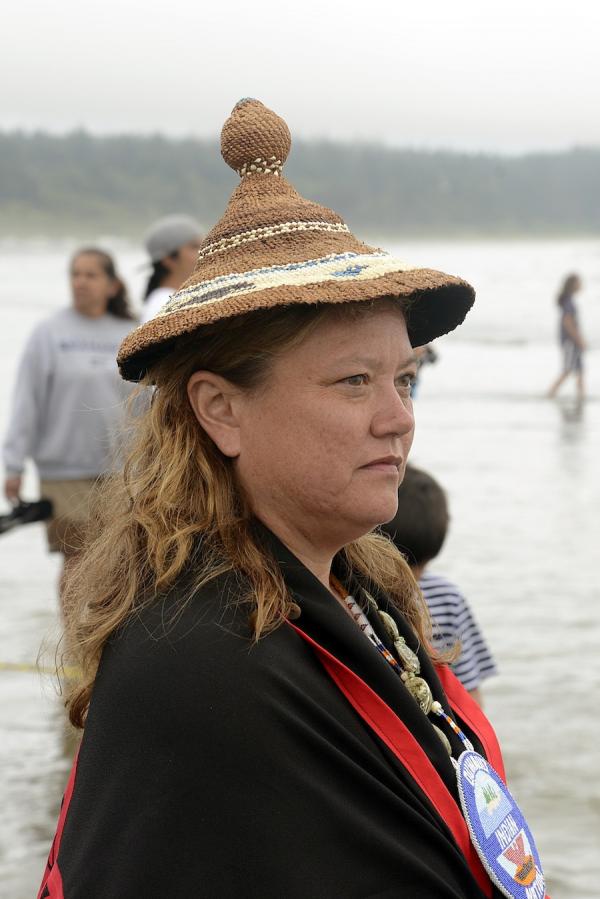Source: Indian Country Today Media Network, November 14, 2013
Tribal Leaders from many of the 566 federally recognized tribes were present for the fifth annual White House Tribal Nations Conference held at the Department of the Interior on November 13.
The all day conference that has been a staple of President Barack Obama’s administration and its hopes to improve the government-to-government relations began at 9 a.m. with Cabinet members speaking on behalf of their respective departments.
The speakers addressing the tribal leaders, who were able to voice their concerns later in the day, were: Interior Secretary Sally Jewell, Veterans Affairs Secretary Eric Shinseki, Health and Human Services Secretary Kathleen Sebelius, Transportation Secretary Anthony Foxx, Energy Secretary Ernest Monitz, and the Department of Justice Attorney General Eric Holder.
Each speaker addressed progress in working with Indian country over the past year as well as announced key programs in front of the Native leaders.
Below are 13 clips from the morning session as the Cabinet members addressed the gathering:
Holder: “[C]ountless tribal leaders – both in and beyond this room – have stepped to the forefront of our efforts to preserve cultural values, to enforce treaty obligations, and to secure the rights and benefits to which all American Indians and Alaska Natives must always be entitled. Together, through many generations, you and your predecessors have faced down tremendous adversity – standing up to those who once sought to terminate the federal government’s relationships with tribes. You’ve galvanized support for the rights of American Indians to maintain tribal governments – and to have a seat at the table before major reforms are enacted. You’ve mobilized tribal nations to win passage of long-overdue laws not simply to regulate tribal affairs, but to allow all Native peoples to fulfill their own promise and chart their own paths.”
Shinseki: “I cannot change the records of injustice in our history, and they are many or the lack of trust about the government and this department, but I intend to make things better and I need your help.”
Sebelius: “Our research shows that nearly one in three American Indians and Alaskan Natives don’t have health insurance, one in three. That compares to 62 percent of all non-elderly Americans who are covered with insurance. But in Alaskan Native and American Indian communities only six percent are covered – here the challenges they face are real.”
Foxx: “The department of transportation’s position is clear. Residents of our tribal nation need and deserve safe roads and bridges and access to reliable public transportation. You well know, as well as I do, that transportation is a life-blood to communities, families. When we deliver on the promise of connecting every person on these shores to 21st-century opportunities, that includes tribal communities all across America.”
Moniz: “We want to work closely with tribal leaders to develop renewable resources on tribal lands, in particular. Today, we are very pleased to announce that nine tribes have been selected to receive over $7 million to further deploy clean energy projects.”
Jewell: “I came in at an interesting time as far as the budget. It was with my predecessors and some of the things they faced. We think long-term. We think the future of the culture that you represent, of the land you represent, we think by generations forward, as do I. And yet we are all faced with a crazy budget situation, continuing resolutions, no budget since 2012. Sequestration has hit Indian country harder than any other part of the federal government through the sequestration period we have been enduring since I started in the job seven months ago.”
Holder: “Today, we declare that we must never forget. We must never deny the injustice that – for decades upon decades – was inflicted on Native peoples. And we affirm that this painful past has informed, and given rise to, a sustained period of cooperation and self-determination – a period that began in a moment of national challenge, when the nation confronted a New Frontier.”
Jewell: “I know that when I speak to individual members of Congress they care about Indian country, and your voices to them are really, really important. But when it comes down to actually getting a budget done, they aren’t delivering. We need to hold them accountable to that and we will certainly be your partners in that effort.”
Sebelius: “Before President Obama took the oath of office, there was a steady decline in the number of children in Head Start who spoke a tribal language at home. Today we are using the Head Start new performance standards to integrate tribal language and culture into classrooms and curriculum. That is a big step forward for the next generation.”
Moniz: “This department has a major challenge in terms of cleaning up – there is no nice way to say it – the cold war mess. Much of this has an impact on traditional tribal lands. When it came to establishing our programs, I have to say, tribes in the affected areas, they have been fantastic partners in making us focus on the long-term cleanup to a level where sufficient activities could be removed. That has been a tremendous help as we structure the programs.”
Shinseki: “President Obama and I are committed to providing equal access to all veterans. If you understand the spread and the difference in the landscape, you will appreciate that the commitment means that whether or not you are living in an urban area or are a rural veteran, you are in the most remote of locations, like the outer banks of Alaska, or maybe even Guam, seven miles beyond Honolulu. Our commitment is to provide as best we can equal access to every veteran, no matter the condition, and that includes veterans on tribal lands. With the support of the congress, the president has increased the budget request for V.A. by over 50 percent since 2009. Rural, urban, remote, Native American all in the same benefits.”
Foxx: “We know and you know that a rebuilt road or a new transit system can be the difference between a child getting to school on time or the difference between an elder going to the doctor or not. No one knows better than the American tribal leaders that safe, reliable transportation is a key to accessing good jobs. It is why last year the federal transit administration awarded more than copy5 million from our tribal transit program to help 72 tribal governments provide the critical transportation services that thousands depend on every day.”
Holder: “We must recommit ourselves to collaboration on an unprecedented scale – no matter the obstacles we face. And we must declare – together – that, despite everything that’s been achieved, we will not rest as long as crime rates in so many tribal communities continue to exceed the national average.
“We will not accept the shameful fact that American Indians are disproportionately likely to become victims of crime and violence.”
Read more at http://indiancountrytodaymedianetwork.com/2013/11/14/13-cabinet-comments-tribal-nations-conference-morning-session-152246












